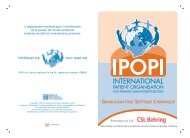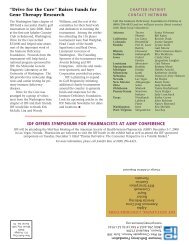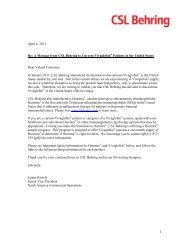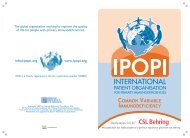IDF Patient & Family Handbook for Primary Immunodeficiency ... - IDFA
IDF Patient & Family Handbook for Primary Immunodeficiency ... - IDFA
IDF Patient & Family Handbook for Primary Immunodeficiency ... - IDFA
Create successful ePaper yourself
Turn your PDF publications into a flip-book with our unique Google optimized e-Paper software.
Specific Medical Therapy<br />
93<br />
Introduction<br />
There are several specific medical therapies<br />
available <strong>for</strong> patients with primary immunodeficiency<br />
diseases. Effective therapies <strong>for</strong> these disorders are<br />
a reality <strong>for</strong> most patients, improving their quality<br />
of life and allowing them to become productive<br />
members of society. In this chapter, five established<br />
therapies (immunoglobulin replacement, stem cell<br />
transplantation, granulocyte-colony stimulating<br />
factor, gamma interferon and adenosine deaminase<br />
replacement) and an experimental type of therapy<br />
(gene therapy) will be considered. Their specific<br />
indications, dose and treatment regimens, and<br />
risk/benefit ratios should be discussed with your<br />
physician.<br />
Immunoglobulin Therapy<br />
The term, immunoglobulin, refers to the fraction<br />
of blood plasma that contains “immunoglobulins”<br />
or “antibodies.” Individuals who are unable to<br />
produce adequate amounts of immunoglobulins<br />
or antibodies, such as patients with X-linked<br />
agammaglobulinemia, common variable<br />
immunodeficiency, hyper-IgM syndromes or other<br />
<strong>for</strong>ms of hypogammaglobulinemia, may benefit<br />
from replacement therapy with immunoglobulin. It<br />
is important to understand that the immunoglobulin<br />
that is given partly replaces what the body should<br />
be making, but it does not help the patient’s own<br />
immune system make more. Un<strong>for</strong>tunately, the<br />
immunoglobulin only provides temporary protection.<br />
Most antibodies, whether produced by the patient’s<br />
own immune system or given in the <strong>for</strong>m of<br />
immunoglobulin, are used up or “metabolized” by the<br />
body. Approximately 1/2 of the infused antibodies<br />
are metabolized over 3 to 4 weeks, so repeat doses<br />
are required at regular intervals. Depending on the<br />
route of administration, this may be done by giving<br />
small infusions under the skin as often as every 2 or<br />
3 days, or larger intravenous infusions once every 3<br />
or 4 weeks. Since it only replaces the missing end<br />
product, but does not correct the defect in antibody<br />
production, immunoglobulin replacement is usually<br />
necessary <strong>for</strong> the patient’s whole life.<br />
As explained in other chapters of this handbook<br />
(see chapter titled The Immune System and<br />
<strong>Primary</strong> <strong>Immunodeficiency</strong> Disease), B-lymphocytes<br />
mature into plasma cells, which manufacture<br />
antibodies and release them into the bloodstream.<br />
There are literally millions of different antibodies<br />
in every normal person, but because there are so<br />
many different germs, no one person has made<br />
antibodies to every germ. The best way to ensure<br />
that the immunoglobulin will contain a wide variety<br />
of antibodies is to combine, or “pool”, blood from<br />
many individuals.<br />
To commercially prepare immunoglobulin<br />
that can be given to patients with a primary<br />
immunodeficiency, the immunoglobulin must first<br />
be purified (extracted) from the plasma, or liquid<br />
part, of the blood of normal healthy individuals.<br />
Each donor must be acceptable as a blood<br />
donor according to the strict rules en<strong>for</strong>ced by<br />
the American Association of Blood Banks and<br />
the U.S. Food and Drug Administration (FDA).<br />
Donors are screened <strong>for</strong> travel or behavior that<br />
might increase the risk of acquiring an infectious<br />
disease. All immunoglobulin licensed in the U.S.<br />
is made from plasma collected in America. The<br />
blood or plasma from each donor is carefully<br />
tested <strong>for</strong> evidence of transmissible diseases,<br />
such as AIDS or hepatitis, and any sample that is<br />
even suspected of having one of those diseases<br />
is discarded. Plasma is collected from tens of<br />
thousands of donors, and then pooled together.<br />
The first step in immunoglobulin production is to<br />
remove all the red and white blood cells. This is<br />
frequently done right as it comes out of the donor’s<br />
arm by a process called plasmapheresis, which<br />
returns the red and white cells directly back to the<br />
donor. Then, the immunoglobulins are chemically<br />
purified from the liquid plasma in a series of steps<br />
usually involving treatment with alcohol. This<br />
process results in the purification of antibodies<br />
of the immunoglobulin G (IgG) class; only trace<br />
amounts of IgA and IgM remain in the final product<br />
(see chapter titled The Immune System and <strong>Primary</strong><br />
<strong>Immunodeficiency</strong> Disease). The purification<br />
process removes blood proteins other than IgG<br />
and is also very effective at killing viruses and other<br />
germs that may be in the blood.<br />
Immunoglobulin was first used to prevent<br />
infectious diseases in World War II and it was first<br />
given <strong>for</strong> primary immune deficiency in 1952. Until<br />
the early 1980’s, the only <strong>for</strong>m that was available
















